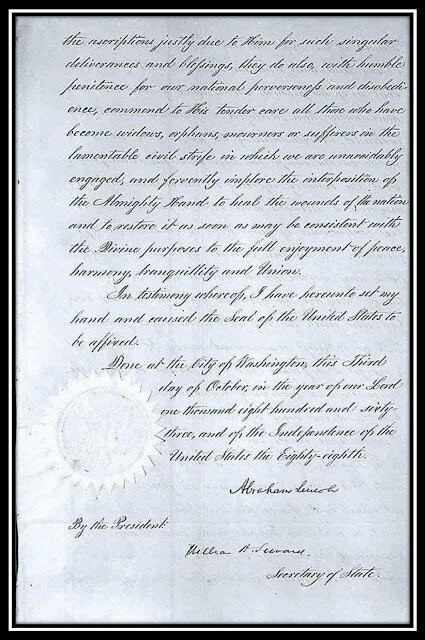Ask any kindergarten teacher and they’ll tell you that once the leaves start to fall, the school calendar is basically a race from one eating holiday to the next. From the sugar high of a pillowcase full of Halloween’s haul, to Thanksgiving’s cornucopia of turkey, dressing, mashed potatoes and pumpkin pie, to Christmas cookies, to the double binge of Valentine’s candy and chocolate Easter bunnies, it’s about time to dig the stretchy pants out of the closet.
But did you know that until The Great Depression, two of those holidays were pretty much combined? Yes, Thanksgiving was when children would dress up and go door to door begging for treats, and some adults played impish pranks as part of the holiday celebration. While there probably aren’t too many people still around who remember dressing up as ragamuffins for Thanksgiving, their story is still fascinating.
Thanksgiving didn’t officially become a national holiday until 1863, when Abraham Lincoln set a specific date of celebration for the entire country even though individual cities and states had reenacted the Pilgrims’ feast of thanks for generations. By setting a standardized date of the last Thursday in November to offer thanks for our blessings, Lincoln sought to unify the contentious country in the midst of the Civil War.

Within a decade, the holiday began to take on new traditions, such as when indigent New Englanders would travel from door to door in rich neighborhoods asking for “something for Thanksgiving.” Partly as a joke, and partly because they saw an opportunity, children who didn’t even need the charity began to dress up in rags and beg for treats and alms. By the turn of the 20th century, Thanksgiving had taken on the additional moniker of “Ragamuffin Day” to describe the proliferation of kids dressed up as poor beggars.
Adults played along too, often throwing elaborate masquerade balls and marching through the streets of New York City dressed in outlandish costumes or in drag. The revelers called themselves “Fantasticals,” and a cottage industry was born providing papier-mâché masks to the parade participants as they practiced the new tradition of “Thanksgiving Masking.”

Children didn’t actually start asking neighbors for candy until around the second World War, but the practice of dressing up in tattered clothes and asking for spare change grew more and more popular in the first two decades of the 20th century until urban residents got tired of the ringing of their doorbells on Thanksgiving while they were trying to prepare and enjoy the celebratory feast.
Some meaner New Yorkers actually took to heating coins up on a stove and pitching these “red pennies” out into the street where they would burn the fingers of unsuspecting children scrambling to pick up their Thanksgiving booty. (This is not, however, where the term “red cent” came from. That was a reference to the color of a copper penny.)

By the time The Great Depression set in during the 1930s, most urban dwellers didn’t have a red cent to spare, not even to play a cruel prank on the kids begging for alms at Thanksgiving. New York City schools and civic organizations began to set up costume contests and parades around Halloween, a holiday which had previously been shunned by the Puritans of New England for its pagan roots. As a way to cheer up children during the hard conditions of the Depression, Halloween became popularized and distanced itself from religious aspects of All Hallows’ Eve.
After the partying of late October, Thanksgiving became more reverent and revolved around family. The costumes of “Thanksgiving masking” switched to Halloween, following along with the Scottish and Irish practice of “guising,” where children in costume would visit neighbors to ask for food or coins. In modern day, no one would confuse the two holidays, other than that they are both opportunities for Starbucks to push pumpkin spice lattes. But if things had been different, we wouldn’t have been able to enjoy the autumnal tradition of watching both “It’s the Great Pumpkin, Charlie Brown” and “A Charlie Brown Thanksgiving.” That would definitely not be a treat or something to give thanks about.
Happy Halloween, and have a safe night of trick-or-treating!
**********
Keep up with interesting facts, fascinating stories and more — subscribe to StyleBlueprint!



















